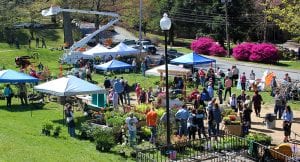On April 28, I attended the Native Plant Sale and Arbor Day Celebration at Montreat College, near Asheville, NC to talk about the American chestnut and its restoration, and to learn about other’s interests. I decided to “jack up” my conversations with folks, having been inspired by a storytelling workshop I recently attended at TACF’s Board of Trustees spring meeting at Meadowview Research Farms in Meadowview, VA.
While talking about the American chestnut, I asked people what they wanted from the discussion. One interesting question asked was “How would mushrooms be affected if planted under a transgenic American chestnut tree?” I did not have an answer but followed up later with the gentleman who asked the question, learning that he recently joined the Asheville Mushroom Society. In search of an answer, I contacted Dr. William Powell, TACF committee member and co-director of The American Chestnut Research & Restoration Project at the State University of New York – Environmental Science and Forestry (SUNY-ESF). He was very helpful, sending a detailed report, which I shared with the person who had asked about this. I find it important to follow up on such conversations.

A birds-eye view of the event. Photo by Mason Blake
Being on TACF’s Education Subcommittee and having an interest in reconnecting children to nature, I attended a presentation sponsored by the NC Arboretum that featured its Discovery Camp program. The presentation was well attended by parents and children. The presenter used remarkable props, such as a live box turtle to draw children into the discussion and to have them participate enthusiastically. Other presentations at this event were offered by the North Carolina Forest Service and the Montreat Tree Board.
Before packing up at the end of the day, I stopped by a native plant booth and bought two Jack-in-the-Pulpit plants to take home to Charlotte to propagate. They will remind me to work on “jacking” up my future presentations!
Jack-in-the-pulpit is an intriguing wildflower native to eastern and midwestern North America, but is easily grown in shade gardens elsewhere. It gets its common name from its odd flower: a pouch-shaped spathe (“pulpit”) with an overhanging hood that surrounds a fingerlike central spadix (“Jack”).
